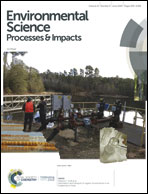Assimilation and transport of organic bound tritium in an irrigated pine forest†
Abstract
The speciation of radioactive tritium (T) in a naturally-established subtropical loblolly pine forest that has been irrigated with highly-contaminated pond water for the last 20 years is reported. This irrigation project was created to limit the underground transport of a tritium-rich plume which also contains low levels of toxic organics, metals and radionuclides such as carbon-14 (14C) from a nearby low-level waste burial ground. The levels of tritiated water (HTO) in the wood cores were not influenced by recent irrigation activities. However, the tritium levels in the last 20 years of tree growth were more than 3-fold higher than that of tritium in the older growth. This was due to recent irrigation with organic-bound tritium (OBT)-rich water and subsequent accumulation of high levels tritium as OBT relative to tissue HTO. High levels of pond irrigation water OBT resulted from biogenic processes that converted HTO to OBT. Data for 14C that were acquired for some of the forest materials indicated that the processes controlling the movement and accumulation of 14C in this system are somewhat different than that of tritium. Spectroscopic characterization of tree core tissue of <20 years in age found no explanation for the unusually wide dark growth rings. It was concluded that the trees were over-irrigated based on results from other published studies with wood from severely-flooded areas. Although HTO is indeed toxic to biota, OBT represents a relatively greater hazard to biota because it can be bioaccumulated and retained for long periods of time in living tissues.

- This article is part of the themed collection: ESPI Cover Art 2019


 Please wait while we load your content...
Please wait while we load your content...
